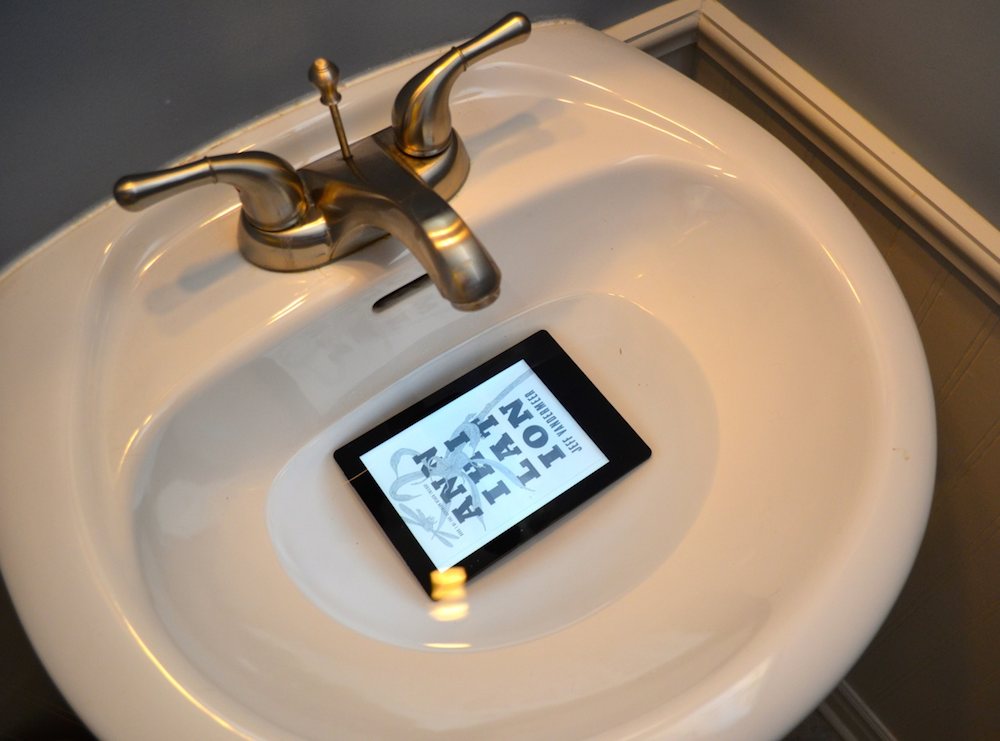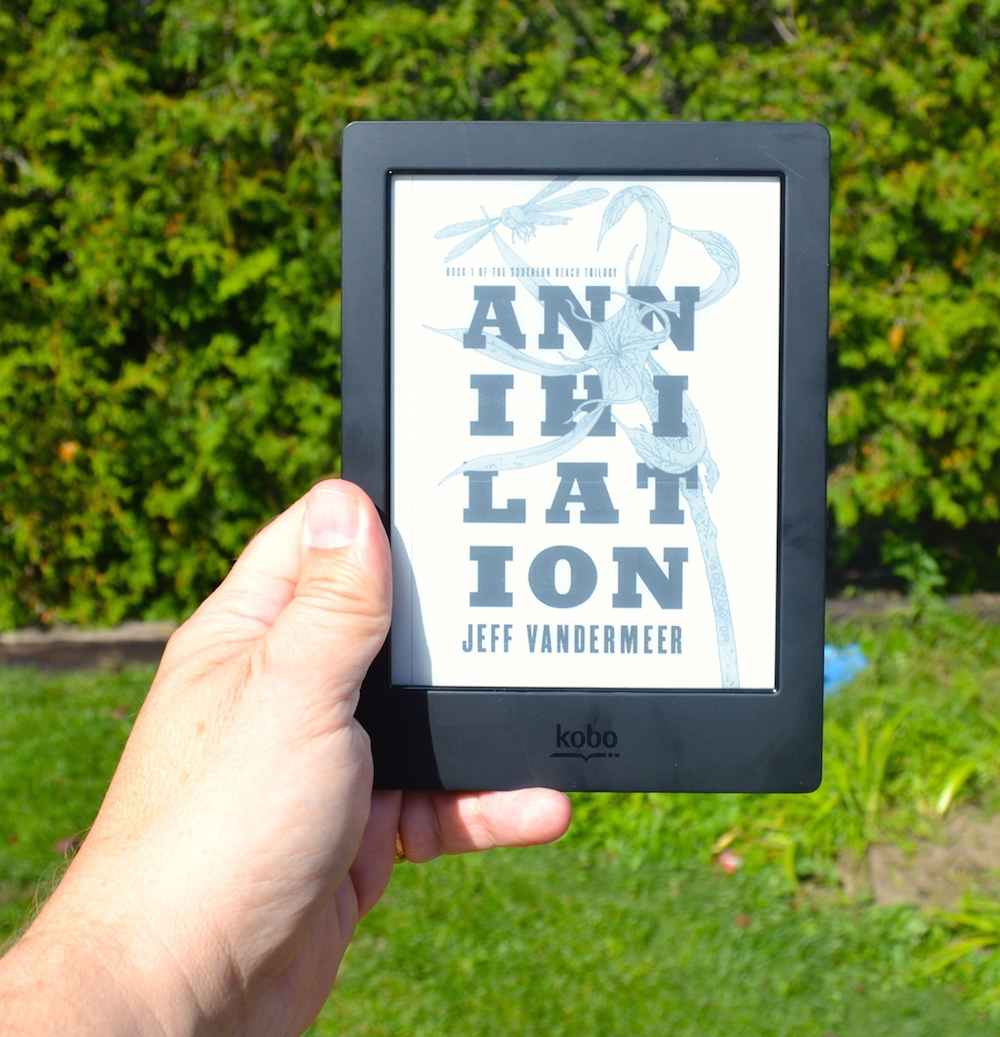
If you are someone who casually reads e-books, then you probably don’t need a device like the Kobo Aura H2O. A smartphone or tablet will likely do just fine. But if you’re someone like me —an avid reader who’s fully committed to digital— then the new Aura H2O is the biggest news since last year’s Kobo Aura HD. I’ve been using Kobo’s latest flagship e-reader and even gone so far as dunking it in a sink full of water. Read on to see just how good this premium e-reader is.
 Like the Aura HD (and That’s a Good Thing)
Like the Aura HD (and That’s a Good Thing)
I reviewed Kobo’s Aura HD last year and proclaimed it the best e-reader on the market. The approach Kobo took with this device by seriously upping the specs to deliver a premium e-reader while competitors were focusing on cutting costs to bring the price of e-readers down paid off handsomely.
The Aura H2O is very much like the Kobo Aura HD.
Aside from gaining its IP67 waterproof and dustproof certification, it’s a bit thinner and weighs slightly less, as you can see from the photo on the left (the Aura HD is beneath the new Aura H2O). The Aura H20 also lost the red slider power switch in favour of a pushbutton and there is no separate power for the ComfortLight illumination — that’s all handled through software now. The case still has the crease or fold effect on the back that helps with grip but it’s a little more subltle and the case finish is less polished plastic and more of a slightly rubberized effect.
Battery life is still rated at two months. I couldn’t verify that during the test duration, but I recharge my Aura HD once a month, and it’s used daily with 30 minutes to an hour of reading at night with its light turned on. I expect the Aura H2O will perform to the same level.
High Resolution Display
Like the Aura HD, the Aura H20 rocks a 6.8-inch display (bigger than the average e-reader which uses a 6-inch panel) at a very high 265 ppi pixel density. This makes text on the Aura H2O look as crisp as on a tablet and compared to typical e-reader displays —which are well under 200 ppi— the difference is like night and day.
I couldn’t find any published differences between the panel used in the Aura HD and the Aura H2O (Kobo says they’re both Carta E Ink HD touchscreens with an identical pixel density). However, I found that when viewed side-by-side, the Aura H2O’s display had noticeably higher contrast. The text was darker and the background less grey. You can see that in the photo below, with the older e-reader on the left and the new Aura H2O on the right. That’s a nice improvement.

As with any E Ink display, the Aura H2O looks just as good (if not better) outdoors, in bright sun.
And, like the Aura HD, the Aura H2O uses Kobo’s ComfortLight illumination. It’s very even, adjustable, effective, easy on the eyes (unlike a tablet, the display is not backlit) and still allows for excellent battery life. On the Aura H20, the light is turned on and off through software —tap the middle of the screen to access the control.
Waterproof (and Dust-proof)
The big selling point for the Aura H2O and its key advantage in a market for premium e-readers that now has competition, is its namesake feature: it’s IP67 certified waterproof. That means it can be submerged for up to 30 minutes in up to one metre of water without harm.
And yes, I tested this out.

It made me cringe to put the e-reader in the sink and turn on the tap, but the Aura H2O functioned perfectly well while completely submerged in water. Dry it off (Kobo even includes a wiping cloth although a towel will do) and it’s as good as new.
This has serious implications for vacation use. I always bring an e-reader, but beaches and pools are really dicey and protective cases add bulk and tend to interfere with use. Having a Kobo Aura H2O means no longer having to fear sand or water and we already know E Ink displays look fabulous in the sun. This is the ultimate e-reader for summer.
Software and Kobo Bookstore
Software like Kobo Reading Life has always been a highlight of Kobo’s e-readers and the Aura H2O takes full advantage of everything from tracking your Reading Stats to the ability to share your e-book choices on Facebook.
TypeGenius means 10 fonts in 24 sizes with adjustable weight and sharpness for a completely personalized and optimized reading experience.
And Kobo’s e-bookstore (which you can access wirelessly via Wi-Fi with the Aura H2O) offers nearly 4 million titles.
 Should You Buy It?
Should You Buy It?
If you are a reader who’s transitioned to the digital world, any dedicated E Ink e-reader is going to provide a superior experience to a tablet, smartphone or laptop. Multipurpose devices are great for being able to do a decent job at just about anything, but a dedicated e-reader offers numerous advantages including battery life (weeks or months instead of hours), a glare-free outdoor experience and the ability to read without the distraction of notifications.
The question is, will you benefit from the extra features of the Kobo Aura H2O?
For many readers, I would suggest that yes, the premium Aura H2O is completely worth a bump in price over typical e-readers. The larger display translates into more text on the page while its 265 ppi resolution makes that text just as crisp as a printed page —perhaps even sharper. The waterproof and dust-proof case is what seals the deal. This is an e-reader you can take to the beach, read by the pool, use in the bath tub or bring along on your daily commute (regardless of rain).
I loved the Aura HD and Kobo’s strategy of going upmarket with that device instead of the constant trend toward making e-readers cheaper. The Aura H2O is even better. If you spend a lot of time reading e-books, you won’t be disappointed.



